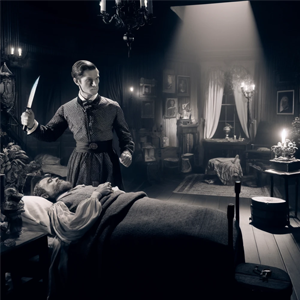In the dark annals of American history, few events are as chilling and audacious as the conspiracy to assassinate President Abraham Lincoln. While John Wilkes Booth’s successful assassination of Lincoln is well-documented, the simultaneous attempt on Secretary of State William H. Seward’s life by Lewis Powell is a grim reminder of the extent of the conspiracy that sought to decapitate the Union government at the close of the Civil War.
The conspiracy, orchestrated by John Wilkes Booth, aimed not only to assassinate President Lincoln but also to eliminate key members of his administration. This included Vice President Andrew Johnson and Secretary of State William H. Seward. Booth believed that by killing these leaders simultaneously, the conspiracy would throw the U.S. government into disarray, avenging the South’s defeat and potentially reviving the Confederate cause.
 On the night of April 14, 1865, Seward was confined to his bed, recovering from a severe carriage accident that had occurred ten days prior. This accident left him with a broken arm and jaw, making him an easier target for the conspirators. Powell, a former Confederate soldier and co-conspirator, was assigned the task of killing Seward.
On the night of April 14, 1865, Seward was confined to his bed, recovering from a severe carriage accident that had occurred ten days prior. This accident left him with a broken arm and jaw, making him an easier target for the conspirators. Powell, a former Confederate soldier and co-conspirator, was assigned the task of killing Seward.
Lewis Powell approached the Seward residence armed with a revolver and a Bowie knife. Using the ruse that he had been sent with a prescription for Seward, Powell convinced a servant to allow him entry into the home. Despite being denied entry to Seward’s bedroom, Powell violently pushed past Seward’s son, Frederick, and made his way up to the bedroom where Seward lay incapacitated.
Inside the bedroom, Powell commenced a frenzied attack. He slashed at Seward’s face and neck with the Bowie knife, seriously wounding him. In the chaos, other members of the Seward household attempted to intervene. Seward’s other son, Augustus, and a male nurse suffered injuries in the struggle to subdue Powell. Despite his serious wounds, Seward survived the assassination attempt, a testament to the resilience and quick action of those present.
The attack left William Seward with deep facial scars and further complicated his recovery from the carriage accident. His son, Frederick, was left unconscious and severely injured after being struck on the head by Powell when he first attempted to block Powell’s access to his father’s room. The male nurse and Augustus also sustained injuries during the altercation, although they eventually recovered.
The attack on Seward and his family sent shockwaves through Washington, amplifying the horror of Lincoln’s assassination. It underscored the vast scope of Booth’s conspiracy and its aim to destabilize the Union government in its entirety.
In the immediate aftermath, the city of Washington was plunged into a state of high alert as authorities realized the assassination of Lincoln was part of a larger plot. The attacks catalyzed a massive manhunt for the conspirators involved.
Lewis Powell was captured shortly after the failed assassination attempt. During his trial, which was held alongside those of his co-conspirators, Powell was found guilty of complicity in the conspiracy to assassinate Lincoln and attempt to murder Seward. He was sentenced to death and executed by hanging in July 1865.
The attempted assassination of William H. Seward and the successful assassination of Abraham Lincoln are indelibly etched into the fabric of American history. These events underscored the deep divisions and tumultuous emotions of the Civil War era. The attacks are remembered not only for their brutality but also for the resilience of the American government in the face of an unprecedented crisis. The survival of Seward, in particular, symbolizes the failure of the conspiracy to achieve its ultimate goals of undermining the Union and altering the course of American history.
Leave a comment